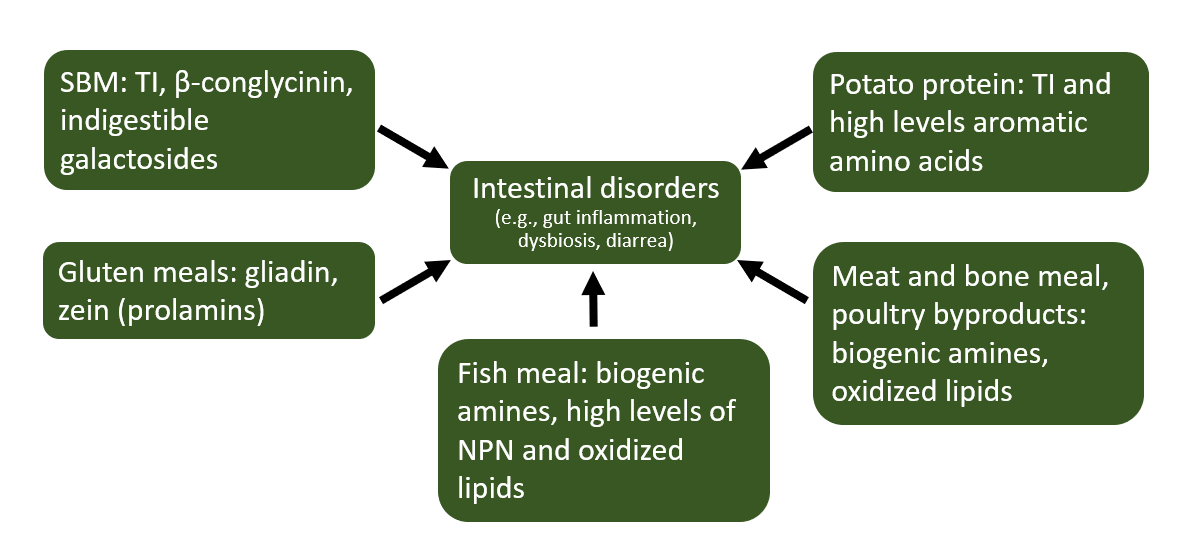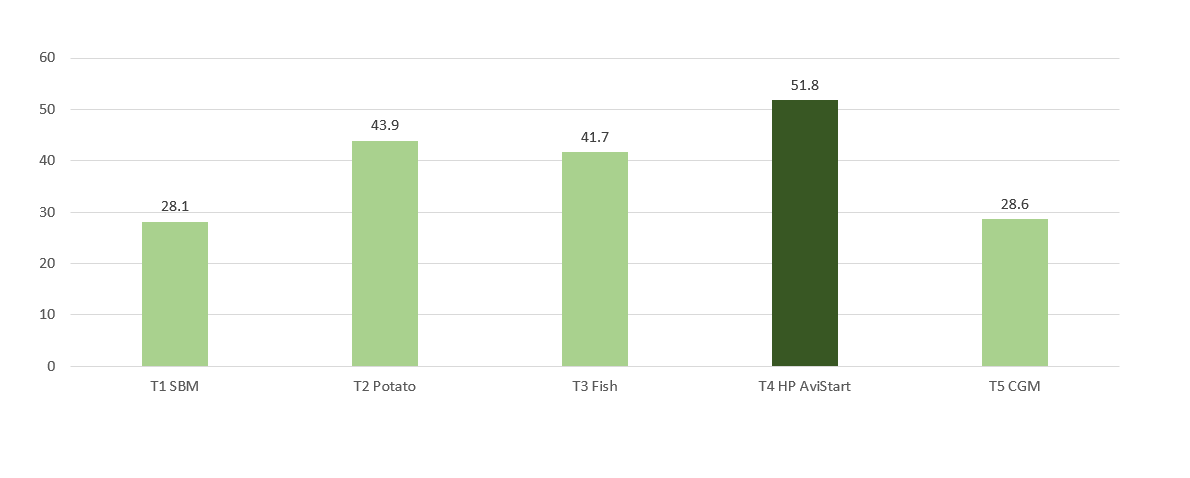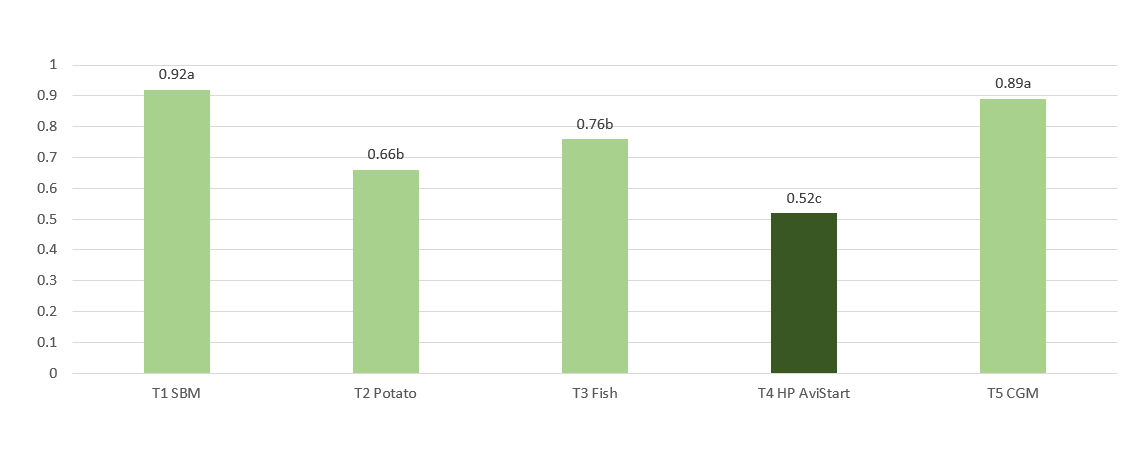



Enzyme-treated soy protein in broiler (pre-) starter feed helps alleviate footpad dermatitis on farm
The dark side of soybean meal in chicken feed
In several articles recently published on this website (Blanch, 2020 a, b; Blanch, 2021), it has been shown that some anti-nutritional factors (ANF’s) in soybean meal (SBM) compromise the intestinal function and health of chickens. The three most harmful ANF’s for birds are trypsin inhibitors (TI), the antigen beta-conglycinin and the galactosides stachyose and raffinose. High levels of each one of them in chicken feed, directly or indirectly, can lead to the presence of diarrhea and consequently wet litter, which will predispose to suffering from footpad dermatitis (FPD), one of the main concerns regarding the welfare of the birds.
TI are especially dangerous in young chicks, who are deficient in trypsin, particularly during the first four days of life, achieving a consistent level after 10 days of life. If the gut of young birds is poor in trypsin and, in addition, high levels of TI are contained in feed, their already poor digestion of protein is further aggravated. Furthermore, the antigen beta-conglycinin is also a protein. Therefore, endogenous proteases are supposed to attack it and thus avoid its damaging action against the intestinal epithelium. However, young chicks can hardly get rid of beta-conglycinin due to their low availability of trypsin, having a higher risk of intestinal inflammation.
Among all SBM ANF’s, those that most directly predispose to diarrhea in chickens are stachyose and raffinose. These galactosides are not digested in the small intestine of birds because they do not have alpha-galactosidase enzyme to break their molecules. Therefore, they end up intact in the large intestine and caeca. The portion of stachyose and raffinose that is not fermented there exerts an osmotic effect, getting watery digesta and, consequently, diarrhea, wet litter and most probably FPD. This issue is especially relevant in chicks less than 14 days old because they do not have their intestinal microbiota well founded yet and are therefore less competent to ferment those undigested stachyose and raffinose.
Difficult to find good alternatives
Due to the susceptibility of young chicks to soy ANF’s, poultry nutritionists find it necessary to substantially reduce the amount of SBM in their (pre) starter diets, without giving up on fulfilling the high amino acid requirements of birds at that early age. Various are the non-soy feed ingredients that are used to fill the gap left by SBM in the (pre-) starter formula. However, it is difficult to find the ideal ingredient since, to a greater or lesser extent, all may have ANF’s or inconsistencies that lead to intestinal disorders, such as inflammation, dysbiosis and potentially diarrhea (Figure 1), as reported by different authors (Gordon, 1996; Palliyeguru et al, 2010, 2011; Fernando et al, 2011; Ortiz-Sánchez et al, 2016; Kogut et al 2018; Lauridsen, 2019; Zanu et al, 2020). The aforementioned intestinal conditions can easily lead to FPD.

Another possibility to replace SBM in chicken (pre-) starter feeds is to incorporate processed soy products to reduce the ANF's content. Processing of SBM can indeed reduce the adverse effects caused by soy ANF’s. However, high temperatures are reached in most of these processes. In fact, heating effectively inactivates ANF’s by denaturing protein structures. Nevertheless, excess heating, besides inactivating ANF’s, may result in loss of amino acid digestibility by Maillard reactions. Furthermore, not all ANF’s are inactivated by heat. An efficient solution to this issue is indeed[NB1] state-of-the art enzymatic treatments to fully inactivate soy ANF’s. The use of specific enzymes avoids the need for high and extended use of heat, resulting in soy protein ingredients that allow young birds to use the full nutrient potential of SBM.
Enzyme-treated soy protein, the ingredient of choice…
The effect of replacing SBM with different protein alternatives during the starter period on performance and FPD incidence and severity in broiler chickens was assessed in a study undertaken at the University of Novi Sad, Serbia (Bjedov et al, 2015). The experiment had five dietary treatments (starter diets) as follows:
T1, 34.4% SBM
T2, 24.2% SBM + 5% potato protein
T3, 24.4% SBM + 5% fish meal
T4, 27.2 % SBM + 5% enzyme treated SBM (HP AviStart, Hamlet Protein A/S, Denmark)
T5, 28% SBM + 5% corn gluten meal (CGM)
All tested starter feeds had the same energy content and similar protein content. Feeding with starter diets lasted for 11 days, after which all groups consumed the same grower feed (from 12-28 days) and finisher feed (29-42 days).
No significant difference among treatments for body weight at day 42 was found. However, significant differences in FCR among dietary treatments were observed (Table 1).
[NB1]Use is instead of are

What the results of this study revealed is a strong impact of the type of protein source in the starter diet on the incidence and severity of FPD at the end of the production cycle (day 42), as shown in Figures 2 and 3.


The authors corroborated that the use of alternative proteins to SBM, such as fish meal, potato protein or enzyme-treated soy protein, in starter feeds for chickens has a positive effect on the incidence and severity of FPD at the end of the production cycle, whereas the inclusion of CGM did not improve FPD. Enzyme-treated soy protein (HP AviStart), without a doubt, is the alternative that results in the best productive results and, at the same time, in the lowest FPD incidence and severity. The extremely low content of ANF's in this bio-processed vegetable protein, as well as its high nutritional value, explain its superiority compared to other protein sources. Thus, a good strategy to reduce the risk of FPD in chickens is to decrease the inclusion of SBM in the starter feed to below 30% and to supplement the diet with protein sources with an extremely low content of ANFs, such as enzyme-treated soy protein.
| References | ||||
|---|---|---|---|---|
| Bjedov et al. (2015). Effect of replacing soybean meal with different protein sources during starter period on performance and foot pad dermatitis in broilers. In: Proceedings of the 20th European Symposium on Poultry Nutrition (ESPN) 2015., 24–27 August 2015, Prague, Czech Republic: 507-509 | ||||
| Blanch A. (2020a). Soy trypsin inhibitors do affect the growth and gut health of chickens. https://www.thepoultrysite.com/articles/soy-trypsin-inhibitors-do-affect-the-growth-and-gut-health-of-chickens | ||||
| Blanch A. (2020b). Soy oligosaccharides and beta-conglycinin, behind gut inflammations, wet droppings and footpad dermatitis in chickens. https://www.thepoultrysite.com/articles/soy-oligosaccharides-and-beta-conglycinin-behind-gut-inflammations-wet-droppings-and-footpad-dermatitis--n-chickens | ||||
| Blanch A. (2021). Bird welfare in poultry production: dietary soy α-galactosides do play a role! https://www.thepoultrysite.com/articles/bird-welfare-in-poultry-production-dietary-soy-α-galactosides-do-play-a-role | ||||
| Fernando P.S. et al (2011). Effect of diets containing potato protein or soya bean meal on the incidence of spontaneously-occurring subclinical necrotic enteritis and the physiological response in broiler chickens. Br. Poult. Sci. 52: 106—114 | ||||
| Gordon T. (1996). Biogenic amines in meat meal US.021. In: PPI by Meat & Livestock Australia Limited ABN 39 081 678 364: 1-101 | ||||
| Kogut M.H. et al. (2018). Inflammatory phenotypes in the intestine of poultry: not all inflammation is created equal. Poult. Sci. 97:2339–2346 | ||||
| Lauridsen C. (2019). From oxidative stress to inflammation: redox balance and immune system. Poult. Sci. 98:4240–4246 | ||||
| Ortiz-Sánchez J.P. et al (2016). Prolamins of maize and wheat differentially affect intestinal cells both in biopsies of celiac patients and CACO-2 cell line. Food Agric. Immunol., 27:2, 259-272, DOI: 10.1080/09540105.2015.1086316 | ||||
| Palliyeguru M.W.C.D. et al. (2010). Effect of dietary protein concentrates on the incidence of subclinical necrotic enteritis and growth performance of broiler chickens. Poult. Sci. 89 :34–43 | ||||
| Palliyeguru M.W.C.D. et al. (2011). Effect of trypsin inhibitor activity in soya bean on growth performance, protein digestibility and incidence of sub-clinical necrotic enteritis in broiler chicken flocks. Br. Poult. Sci. 52: 359-367 | ||||
| Zanu H.K. et al (2020). Influence of meat and bone meal, phytase, and antibiotics on broiler chickens challenged with subclinical necrotic enteritis: 1. Growth performance, intestinal pH, apparent ileal digestibility, cecal microbiota, and tibial mineralization. Poult. Sci. 99: 1540-1550 | ||||










